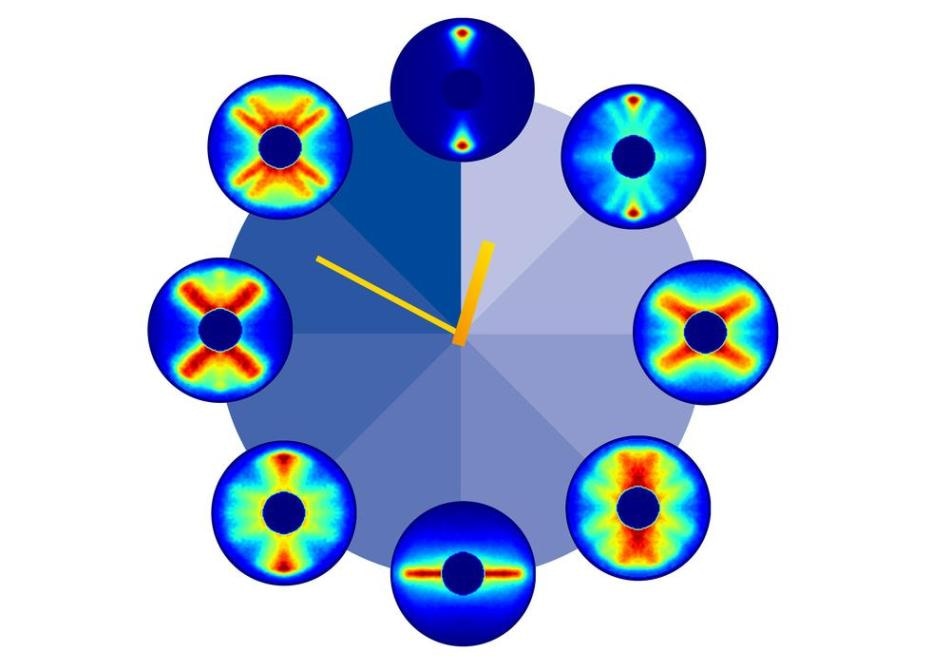Jul 30 2019
Researchers have filmed the ultrafast rotation of a molecule by using precisely tuned laser pulses.
 The different stages of the molecule’s periodic rotation repeat after about 82 picoseconds. (Image credit: DESY, Evangelos Karamatskos/Britta Liebaug)
The different stages of the molecule’s periodic rotation repeat after about 82 picoseconds. (Image credit: DESY, Evangelos Karamatskos/Britta Liebaug)
The ensuing “molecular movie” monitors one and a half revolutions of carbonyl sulfide (OCS)—a rod-shaped molecule including one oxygen atom, one carbon atom, and one sulfur atom—that occur within 125 trillionths of 1 second, at a high spatial and temporal resolution.
The researchers, led by DESY’s Jochen Küpper from the Center for Free-Electron Laser Science (CFEL) and Arnaud Rouzée from the Max Born Institute in Berlin, have presented the study outcomes in the Nature Communications journal. CFEL is a collaboration between DESY, the Max Planck Society, and Universität Hamburg.
Molecular physics has long dreamed of capturing the ultrafast motion of atoms during dynamic processes on film.
Jochen Küpper, Center for Free-Electron Laser Science, DESY
Küpper is also a professor at the University of Hamburg.
However, this is not simple because, in the world of molecules, high-energy radiation with a wavelength of the order of the size of an atom is usually required to be able to observe the details.
Therefore, Küpper and his colleagues resorted to a different strategy: they set the carbonyl sulfide molecules to spin rapidly in unison (or coherently) by using two pulses of infrared laser light precisely tuned to each other and separated by 38 picoseconds, where 1 picosecond is one-trillionth of 1 second. Then, they determined the molecules’ position at intervals of about 0.2 trillionths of a second each by using another laser pulse with a longer wavelength.
Since this diagnostic laser pulse destroys the molecules, the experiment had to be restarted again for each snapshot.
Evangelos Karamatskos, Study Principal Author, CFEL
The researchers took a total of 651 images that covered one and a half periods of the molecule’s rotation. When the pictures were assembled sequentially, a 125-picosecond film of the rotation of the molecule was produced. To complete one whole revolution, the carbonyl sulfide molecule requires about 82 trillionths of 1 second, or 0.000,000,000,082 seconds.
“It would be wrong to think of its motion as being like that of a rotating stick, though,” stated Küpper.
The processes we are observing here are governed by quantum mechanics. On this scale, very small objects like atoms and molecules behave differently from the everyday objects in our surroundings. The position and momentum of a molecule cannot be determined simultaneously with the highest precision; you can only define a certain probability of finding the molecule in a specific place at a particular point in time.
Jochen Küpper, Center for Free-Electron Laser Science, DESY
The unique features of quantum mechanics can be observed in a number of images of the movie, where the molecule does not just point in a single direction, but in numerous different directions simultaneously—each with a different probability (for example, see the 3 o’clock position in the figure).
“It is precisely those directions and probabilities that we imaged experimentally in this study,” further stated Rouzée. “From the fact that these individual images start to repeat after about 82 picoseconds, we can deduce the period of rotation of a carbonyl sulphide molecule.”
The researchers consider that their technique can also be employed for other molecules and processes, for instance, to analyze the internal twisting, or torsion, of molecules or chiral compounds. Chiral compounds are compounds occurring in two forms, which are mirror images of each other—quite similar to the left and right hands of a person.
“We recorded a high-resolution molecular movie of the ultrafast rotation of carbonyl sulphide as a pilot project,” stated Karamatskos, summing up the experiment. “The level of detail we were able to achieve indicates that our method could be used to produce instructive films about the dynamics of other processes and molecules.”
Apart from DESY, Universität Hamburg, the Max Born Institute in Berlin, and the University of Aarhus in Denmark also took part in the study.